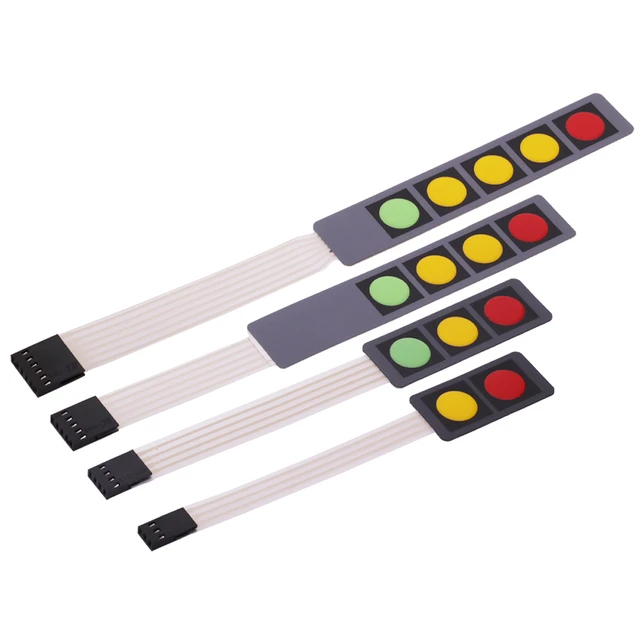Membrane Switch: Reliable, Cost-Effective, and User-Friendly Control Systems
Membrane Switch: Reliable, Cost-Effective, and User-Friendly Control Systems
Blog Article
Recognizing Membrane Switches: The Key to Sturdy and Dependable Controls

What Are Membrane Switches?
Membrane layer buttons are a sophisticated remedy in the world of individual interface innovation, incorporating capability and layout effortlessly. These devices work as a user interface between customers and digital systems, integrating numerous parts into a small layout. Typically created from adaptable, slim layers of products, membrane layer buttons are made to react to touch, allowing individuals to interact with machinery and digital tools properly.
The main aspects of a membrane layer switch consist of a published circuit layer, graphic overlay, and a spacer layer that protects against unintentional activation. The graphic overlay can be customized to show brand identity or individual choices, boosting visual appeals while making sure functionality. Membrane switches are commonly utilized in different applications, including clinical tools, consumer electronics, and commercial devices, owing to their resilience and resistance to environmental aspects such as moisture and dust.
One of the key advantages of membrane layer buttons is their capability to stand up to deterioration, making them perfect for high-traffic settings. Furthermore, they are lightweight and need very little space, enabling ingenious styles in item development. In general, membrane changes represent a reliable and sensible choice for modern-day digital user interfaces, marrying innovation with user-centric design concepts.
How Membrane Switches Over Job
The operation of membrane layer switches over joints on a basic yet reliable system that converts individual input right into electronic signals. When an individual presses the switch, the top layer deforms, enabling a conductive element in the circuit layer to make contact with an equivalent conductive pad on the underside of the graphic overlay.
The style of membrane layer switches can differ, yet they typically integrate domes or responsive elements to provide comments to the individual, boosting the general experience - membrane switch. The materials used in membrane buttons, such as polyester or polycarbonate, contribute to their toughness and resistance to ecological aspects, consisting of moisture and dirt. In addition, the published circuits are commonly encapsulated, which protects them from deterioration gradually.
Benefits of Membrane Switches

In addition, membrane layer buttons are recognized for their toughness. Built from robust products, they are immune to dirt, moisture, and physical wear, which substantially expands their life expectancy contrasted to typical mechanical buttons. This resilience makes them particularly suitable for high-traffic atmospheres and applications calling for durability.
Another considerable benefit is the convenience of cleaning and maintenance. The smooth surface of membrane changes decreases dust accumulation and is usually impervious to spills, making them suitable for settings that call for constant sanitization.
Moreover, membrane layer buttons offer a streamlined profile, bring about a thinner design that can be integrated right into different tools without adding bulk. This attribute not just improves the aesthetic charm but also adds to a more ergonomic item design.
Applications of Membrane Layer Buttons
Straightforward and flexible, membrane layer switches discover applications across a large range of markets, consisting of clinical tools, customer electronics, and industrial devices. In the clinical field, these switches are essential to gadgets such as diagnostic equipment, client surveillance systems, and mixture pumps, where integrity and simplicity of cleaning are important. Their capability to maintain and withstand severe settings performance makes them excellent for such applications.

In customer electronic devices, membrane layer switches are made use of in items like microwaves, cleaning machines, and remotes - membrane switch. Their sleek style permits intuitive interface, enhancing the general individual experience while giving sturdiness and resistance to tear and put on
Commercial devices also gains from membrane switches, particularly in control panels for machinery and automation systems. These switches provide security versus dust and read this post here moisture, ensuring constant efficiency in challenging environments. Additionally, their customizable features permit suppliers to customize them to specific operational demands, enhancing effectiveness and capability.
Picking the Right Membrane Layer Switch Over
When choosing a membrane layer button, it is important to consider various factors that affect efficiency and suitability for certain applications. The main considerations include ecological problems, responsive responses, longevity, and design specifications.
First, evaluate the operating environment; buttons revealed to wetness, chemicals, or extreme temperature levels call for specific materials to make certain longevity and performance. Next, review the requirement for responsive comments. Depending upon customer communication, some applications may gain from a responsive action to verify activation, while others may like a non-tactile design for visual reasons.
Longevity is one more crucial factor; membrane switches must be made to withstand regular click this use, impacts, and abrasion. Ensure the chosen switch can sustain the anticipated lifecycle, specifically in high-usage situations.

Verdict
In conclusion, membrane changes offer as necessary elements in the design of dependable and sturdy control systems across different markets. The adaptability of membrane layer switches allows for customized services that meet particular functional demands, enhancing their importance in modern technology.
Membrane layer switches over represent a critical aspect of modern user interface layout, blending capability with strength in numerous applications.Membrane layer buttons are a sophisticated remedy in the world of customer interface technology, combining performance and style perfectly. Commonly constructed from adaptable, thin layers of materials, membrane layer switches are designed to respond to touch, enabling users to interact with machinery and electronic tools effectively.
The design of membrane buttons can differ, however they commonly incorporate domes or responsive elements to offer responses to the customer, boosting the total experience.In verdict, membrane changes offer as crucial parts in the layout of reliable and durable control systems throughout numerous markets.
Report this page